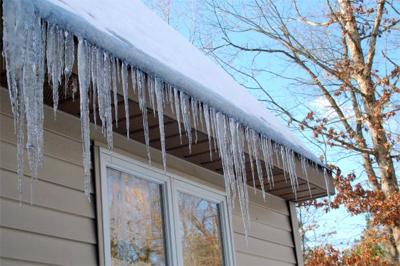Ice damming is a maddening problem that afflicts homeowners in cold climates. According to the Insurance Information Institute, the average home insurance claim for water damage and freezing (which ice dams can cause) is $3,098.
What is ice damming?
During the winter, the heat from your home rises into your attic and exits through your roof. The area of your roof directly under the attic warms up, while the outer edges remain cold, according to the Institute for Business and Home Safety. If there’s snow on your roof, the rising heat melts the snow.
The melted water then drips down the roof and refreezes once it reaches the colder gutter area or overhang. Once the ice dam is formed, it traps the rest of the water running down your roof. This build-up can damage shingles and even tear into your roof, leading to leaks, water damage and mold.
Does home insurance cover damage from ice dams?
Fortunately, according to the Insurance Information Institute, most homeowner’s policies cover damage related to ice dams. However, heading off ice dams can save you the trouble of filing an insurance claim (and possibly paying a deductible) and also help prevent the need to file premium-raising claims every winter.
How can I prevent ice dams?
- Homeowners have several options for battling ice dams:
- Better insulation: Insulate your attic from the rest of the house to avoid heat leaks. Identify and seal off sources of heat leaking, including vents, furnaces, electrical outlets and light fixtures, the Institute for Business and Home Safety recommends.
- Improved ventilation: Proper roof ventilation allows heat to escape your attic (through vents at the edge of the roof, for example) without it warming your roof deck and creating ice dams.
- Protection for the roof: The tactical deployment of “underlayments” — products that create watertight barriers between the deck of your roof and the shingles – won’t be able to stop ice damming but may be able to prevent or minimize damage, according to the Institute for Business and Home Safety.
- Advance preparation: Clear debris and leaves out of your gutters before winter. Also, be on the lookout for signs of dripping, leaking or mold in the attic so that you and your home insurance company can take care of damage before it worsens.

